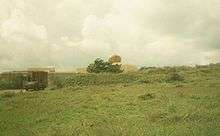Inayat Khan

| Part of a series on |
| Sufi Order Ināyati |
|---|
 |
|
Places of worship |
|
Category:Sufi Order Ināyati |

Inayat Khan Rehmat Khan Pathan (Urdu: عنایت خان; July 5, 1882 – February 5, 1927) was the founder of The Sufi Order in the West in 1914 (London) and teacher of Universal Sufism. He initially came to the West as a Northern Indian classical musician, having received the honorific "Tansen" from the Nizam of Hyderabad, but he soon turned to the introduction and transmission of Sufi thought and practice. Later, in 1923, the Sufi Order of the London period was dissolved into a new organization, formed under Swiss law, called the "International Sufi Movement". His message of divine unity (Tawhid) focused on the themes of love, harmony and beauty. He taught that blind adherence to any book rendered religion devoid of spirit. Branches of Inayat Khan's movement can be found in the Netherlands, France, England, Germany, the United States, Canada, Russia and Australia. In his various written works, such as the Music of Life[1] and The Mysticism of Sound and Music, [2] Inayat Khan interlocks his passion for music with his Sufi ideologies making a compelling argument for music as the harmonious thread of the Universe.
Life
"Hazrat" is an honorific title meaning, roughly, "honorable." Inayat Khan's full name was Inayat Khan Rehmat Khan Pathan.[3] He was born in Vadodara, Gujarat, to a noble family, as on his paternal side (made of mystics and poets) he descended from Pashtuns of Afghanistan initially settled in Sialkot, Punjab,[4][5] and his maternal grandfather, Ustad Maula Bakhsh (1833–1896), called the 'Beethoven of India',[6][7] founded, thanks to the local ruler Maharaja Sayajirao, Gayanshala, an academy of Indian music, and in fact the first of its kind in India,[8] in Vadodara (nowadays serving as the Faculty of Performing Arts, Maharaja Sayajirao University) and whose wife (thus Inayat Khan's maternal grandmother), Qasim Bi, was a granddaughter of Tipu Sultan, the famous eighteenth century ruler of Mysore.[9]
Primarily he represented the Chishti Order of Sufism, having received initiation into the Nizamiyya sub-branch of that order from Shaykh Muhammed Abu Hashim Madani, but was also initiated into the Suhrawardiyya, Qadiriyya and Naqshbandi. His spiritual lineage (Silsila), as compiled by Pir Zia Inayat Khan,[10] follows a traditional lineage from Ali ibn Abi Talib, through Abu Ishaq Shami (d. 940), the founder of the Chishti order, to Nasiruddin Chiragh Dehlavi (d. 1356).
With the Shaykh's encouragement he left India in 1910 to come to the West, traveling first as a touring musician and then as a teacher of Sufism, visiting three continents. Eventually he married Ora Ray Baker (Pirani Ameena Begum), a second-cousin of Christian Science founder Mary Baker Eddy[11][12][13][14] and whose half-brother was the well-known American yogi Pierre Bernard,[15][16] from New Mexico, and they had had four children; Noor-un-Nisa (1914), Vilayat (1916), Hidayat (1917) and Khair-un-Nisa (1919). The family settled in Suresnes near Paris.
In 1922, during a summer school, Inayat Khan had a spiritual experience in the South Dunes in Katwijk, The Netherlands. He immediately told his students to meditate and proclaimed the place holy. In 1969 the Universal Sufi Temple was built there. Khan returned to India at the end of 1926 and there chose the site of his tomb, the Nizamuddin Dargah complex in Delhi where the founder of the Nizami Chishtiyya, Shaykh Nizamuddin Auliya (died 1325), is buried. Khan died shortly after, on February 5, 1927.
Foundational principles
Inayat Khan set forth ten principles that formed the foundational principles of his Universal Sufism:[17]
- There is one God; the Eternal, the Only Being; None exists save He.
- There is one master; the guiding spirit of all souls that constantly leads all followers toward the light.
- There is one holy book; the sacred manuscript of nature, the only Scripture that can enlighten the reader.
- There is one religion; unswerving progress in the right direction toward the Ideal, which fulfills every soul's life purpose.
- There is one law; the law of reciprocity, which can be observed by a selfless conscience, together with a sense of awakened justice.
- There is one brotherhood; the human brotherhood which unites the children of earth indiscriminately in the fatherhood of God. This was later adapted by followers to; "There is one Family, the Human Family, which unites the Children of Earth indiscriminately in the Parenthood of God."
- There is one moral; the love which springs forth from self-denial and blooms in deeds of beneficence. ... (later alternative; "which springs forth from a willing heart, surrendered in service to God and Humanity, and which blooms in deeds of beneficence").
- There is one object of praise; the beauty which uplifts the heart of its worshipper through all aspects from the seen to the unseen.
- There is one truth; true knowledge of our being, within and without, which is the essence of Wisdom.
- There is one path; annihilation of the false ego in the real (later alternative; "the effacement of the limited self in the Unlimited"), which raises the mortal to immortality, in which resides all perfection.
Inayat Khan's emphasis on spiritual liberty led many contemporary Westerners to think that his brand of Sufism is not inherently intertwined with Islam, although his followers continue to perform Dhikr. There is a precedent of masters of the Chishti and some other orders not requiring non-Muslim followers to convert to Islam. The number of non-Muslim Sufis before the twentieth century, however, was usually relatively few.[18]
Bibliography
Books
- Inayat Khan, Hazrat (Prof. 'Ināyat-khān flahmat-khān Pathān). Inäyat gīt ratnāvalī. Baroda and Mumbai: The Auspices of the Government of Sayājīrāo Maharaja Gaekwar, 1903. (Gujarati)
- Inayat hārmoniyam siksak pustak pahalā. Baroda and Mumbai: The Auspices of the Government of SayājMo Mahāiäjā Gāekwār, 1903. (Gujarati. Scores and songs)
- Inayat phidd, siksak. Baroda and Mumbai: The Auspices of the Government of Sayājīrāo Maharaja Gāekwār, 1903. (Gujarati. Scores)
- Minqār-i mūslqār. Allahabad: Indian Press, 1912. (Urdu. Encyclopedia of Indian music and dance).
- A Sufi Message of Spiritual Liberty. London: The Theosophical Publishing Society, 1914. pdf
- Songs of India. London: The Sufi Publishing Society, 1915. pdf
- Hindustani Lyrics. London: The Sufi Publishing Society, 1919. pdf
- "Pir-o-Murshid's Address." The Sufi Quarterly, January, 1920.
- The Unity of Religious Ideals. London: The Sufi Movement, 1921.
- The Way Of Illumination. London. 1924 pdf
- Nirtan or the Dance of the Soul. London: The Sufi Movement, 1928.
- The Divine Symphony or Vadan. London/Southampton: The Sufi Movement, 1931.
- Rasa Shastra: The Science of Life's Creative Forces. Deventer: Kluwef, 1938.
Articles
- "Moula Bux." The Sufi Quarterly 1, no. 3,1915.
- "The Music of India." The Sufi Quarterly 2, April 1916.
Music
Once a classical musician, Hazrat Inayat Khan let go of his greatest attachment-his musical career- to become a Sufist Master, as is the tradition in Sufism.[19] Immersing himself in the Sufist ideology, he found a link between his former life as a musician and his new journey along the spiritual path. Khan saw harmony as the "music of the spheres" which linked all mankind and had the ability to transcend one's spiritual awareness. Inayat Khan's most influential and well known book, The Music of Life, is the definitive collection of Hazrat Inayat Khan's teachings on sound, presenting his vision of the harmony which encompasses every aspect of our lives. He explores the science of breath, the law of rhythm, the creative process, and both the healing power and psychological influence of music and sound.
"What makes us feel drawn to music is that our whoIe being is music; our mind and our body, the nature in which we live, the nature that has made us, all that is beneath and around us, it is all music. We are close to all this music, and live and move and have our being in music.""The mystery of sound is mysticism; the harmony of life is religion. The knowledge of vibrations is metaphysics, the analysis of atoms is science, and their harmonious grouping is art. The rhythm of form is poetry, and the rhythm of sound is music. This shows that music is the art of arts and the science of all sciences; and it contains the fountain of all knowledge within itself." Music should be healing; music should uplift the soul; music should inspire. There is no better way of getting closer to God, of rising higher towards the spirit, of attaining spiritual perfection than music, if only it is rightly understood." - Quote from The Music of Life
Below are some recordings of Inayat Khan's performances during his years as an Indian Classical Musician. It is important to note that although he is the founder of Western Sufism and a musician, the music in these recordings is not associated with Sufi Music - the religious music associated with Sufism.
- Song "Yaman Kalyan Khyal" by Inayat Khan recorded in Calcutta 1909
- «Hindustani songs by prof. Inayat Khan» 16 melodies for piano (1915). Performed by Philip Sear on YouTube
- «Hindustani songs by prof. Inayat Khan» (scores PDF)
References
- ↑ Khan, Hazrat Inayat (2005). The music of life (Omega uniform ed., 1988. ed.). New Lebanon, N.Y.: Omega Press. ISBN 9780930872380.
- ↑ Khan, Hazrat Inayat (1996). The mysticism of sound and music (1. Shambhala ed. ed.). Boston [u.a.]: Shambhala. ISBN 9781570622311.
- ↑ Susheela Misra, Great masters of Hindustani music, Hem Publishers (1981), p. 106
- ↑ Vilayat Inayat Khan, The Message in Our Time: The Life and Teaching of the Sufi Master, Pir-O-Murshid Inayat Khan, Harper & Row (1978), p. 28
- ↑ Zia Inayat-Khan, A Hybrid Sufi Order at the Crossroads of Modernity: The Sufi Order and Sufi Movement of Pir-o-Murshid Inayat Khan, ProQuest (2006), p. 80
- ↑ Elisabeth Keesing, Inayat Khan: A Biography, East-West Publications Limited (1974), p.95
- ↑ Carol Ann Sokoloff in Inayat Khan, The Mysticism of Sound, Ekstasis Editions (2002), p. 11
- ↑ Carol Ann Sokoloff in Inayat Khan, The Mysticism of Sound, Ekstasis Editions (2002), p. 9
- ↑ Parvati Raghuram, Tracing an Indian Diaspora: Contexts, Memories, Representations, SAGE Publications India (2008), p. 241
- ↑ Silsila / Shajara – The Chain of Spiritual Transmission
- ↑ Edward E. Curtis, The Columbia Sourcebook of Muslims in the United States, Columbia University Press (2009), p. 47
- ↑ Phillip Gowins, Practical Sufism: A Guide to the Spiritual Path Based on the Teachings of Pir Vilayat Inayat Khan, Quest Books (2010), p.6
- ↑ Melton, J. Gordon (1999), Religious leaders of America (2 ed.), Detroit, Michigan: Gale Research, p. 299, ISBN 0810388782, OCLC 41000889
- ↑ Melton, J. Gordon; Clark, Jerome; Kelly, Aidan A. (1990), New Age Encyclopedia, Detroit, Michigan: Gale Research, p. 442, ISBN 0810371596, OCLC 20022610
- ↑ Zia Inayat-Khan, A Hybrid Sufi Order at the Crossroads of Modernity: The Sufi Order and Sufi Movement of Pir-o-Murshid Inayat Khan, ProQuest (2006), p. 79
- ↑ Jean-François Mayer, Les nouvelles voies spirituelles: enquête sur la religiosité parallèle en Suisse, L'age D'homme (1993), p. 168
- ↑ In The Spiritual Message of Inayat Khan, Volume I – The Way of Illumination, VOLUME I – I – 1 at wahiduddin.net
- ↑ Carl Ernst and Bruce Lawrence, Sufi Martyrs of Love, New York: Palgrave Macmillan, 2002, p.142. ISBN 1-4039-6027-5.
- ↑ "Khan Introduction". inch.com.
External links
- Centrum Universel an invitation for humanity to become a mureed of God.
- Works by Inayat Khan at Project Gutenberg
- Works by or about Inayat Khan at Internet Archive